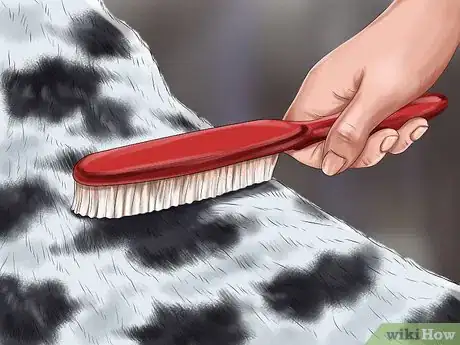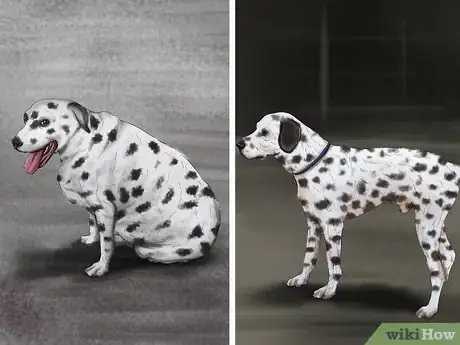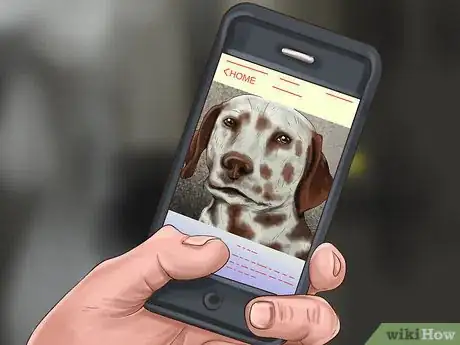This article was co-authored by Pippa Elliott, MRCVS. Dr. Elliott, BVMS, MRCVS is a veterinarian with over 30 years of experience in veterinary surgery and companion animal practice. She graduated from the University of Glasgow in 1987 with a degree in veterinary medicine and surgery. She has worked at the same animal clinic in her hometown for over 20 years.
This article has been viewed 40,233 times.
Dalmatians are a large dog breed that is highly energetic, playful, and loyal. If they are not given enough exercise they can become high strung and may act out by being destructive. In order to identify a Dalmatian, you should examine the dog's coat and other physical characteristics, ask the owner, a veterinarian, or the breeder to help with identification, or get the dog's DNA tested.
Steps
Examining the Dog's Coat
-
1Look at the markings. The best way to identify a Dalmatian is by looking at the dog's markings. Dalmatians are white dogs that have round black or reddish brown spots. Ideally the spots should be distributed across the entire body and there should be no large patches.[1]
- Spots are usually smaller on the head, legs, and tail.[2]
- When Dalmatians are born they are completely white in colour and develop spots as they age.
-
2Acknowledge rare colour variations. Some Dalmatians may have dark blue or tricoloured spots. These colour variations are not accepted as the breed standard for dog shows, but they can still be found on some Dalmatians. Typically tricoloured Dalmatians will be white with dark spots, as well as a few brown patches located on the head, legs, chest, and tail.[3]
- Some Dalmatians may have large black patches on their coat.
Advertisement -
3Feel the dog's coat. The Dalmatian has a short, smooth, and silky coat. When you pet a Dalmatian, the top of their head feels velvety.[4]
-
4Determine if the dog sheds. Dalmatians shed considerably throughout the year. Brush the dog's hair frequently in order to manage the shedding.[5]
Looking at Other Physical Characteristics
-
1Examine the dog's build. Dalmatians are considered a large dog breed with a strong muscular build. The average Dalmatian is about 20-24 inches (50-60cm) tall at the shoulders and weighs 48-55 pounds (22-25kg). Dalmatians have a deep chest and thin tail. Their feet are round with arched toes and the toe nails can be either black or white.[6]
- In order to measure the height of a Dalmatian, use a tape measure and record the distance from the ground to the top of the dog's shoulders.
- Dalmatians will have an athletic and graceful appearance.
-
2Look for brown or blue eyes. The head of a Dalmatian has a similar width and length and the top is flat. Their nose can be black, dark brown, blue or grey and their eyes are brown, blue, or a combination of both.[7]
-
3Recognize deviations. Dalmatians can vary in size based on the individual dog. It is for example, possible to have larger or smaller Dalmatians. This is typically a result of environmental and care factors. For instance, a Dalmatian that is overfed may appear much larger than the breed standard.
-
4Use a dog breed identification app. There are a variety of applications available that can identify different dog breeds. In order to use these apps, upload a photo of a dog and the app will identify the breed.[8]
- For example, try the Microsoft application called Fetch!
- These apps are not always 100% accurate, but the Dalmatian is fairly easy to identify because of the unique spots.
Inquiring About the Breed
-
1Ask the owner. If you see a dog that you think might be a Dalmatian and are curious about the breed, approach the owner and ask. For example, you could say something like “That is a beautiful dog. Is it a Dalmatian by any chance?” Alternatively you could say “What kind of dog is that? I really like its colouring.”
- Most dog owners will be happy to tell you about their dog and the breed.
-
2Ask your veterinarian. If you are unsure of your dog's breed or lineage, ask your veterinarian to help you identify the breed. Veterinarians will be familiar with most dog breeds and will be able to examine the physical characteristics of the dog to help with identifying the breed.
-
3Talk with the breeder. If you are purchasing a Dalmatian from a breeder, you should talk with the breeder about the puppy's parentage and lineage to make sure that you are getting a purebred Dalmatian. A licensed breeder will be able to provide you with paperwork that proves both parents are recognized as Dalmatians by the American Kennel Club.
Testing the DNA of the Dog
-
1Purchase a DNA test kit online. Search Google for a “dog DNA test kit.” These kits cost approximately $80 to $100 and can be ordered online.[9]
-
2Read and follow the instructions. Once you receive the DNA test kit in the mail, open the package and carefully read all of the instructions. The instructions will provide you with steps on how to take a DNA swab and then how to return the results to the lab for testing.[10]
- Each kit is only designed to test the DNA of one dog.
-
3Swab the dog's cheek. The kit will likely come with two swabs. They are both to be used on the same dog. Open your dog's mouth and rub the swab across the inside of the dog's cheek. Do the same thing with each of the swabs.[11]
-
4Mail the kit. Place the swabs into the plastic baggies provided. Then place them in the pre-paid return envelope or box and mail the results to the lab for testing.[12]
-
5Read the results. Approximately three weeks after you completed the test, you will receive detailed DNA results. Your dog's DNA will be compared to approximately 200 different breeds. If you have a Dalmatian, a DNA test will easily be able to identify this breed.[13]
- The results can even test to see if your dog is a mixed-breed that is part Dalmatian.
References
- ↑ http://www.dogbreedinfo.com/dalmatian.htm
- ↑ http://images.akc.org/pdf/breeds/standards/Dalmatian.pdf?_ga=1.219363929.1317900648.1487017438
- ↑ http://images.akc.org/pdf/breeds/standards/Dalmatian.pdf?_ga=1.219363929.1317900648.1487017438
- ↑ http://dogtime.com/dog-breeds/dalmatian#/slide/1
- ↑ http://dogtime.com/dog-breeds/dalmatian#/slide/1
- ↑ http://www.dogbreedinfo.com/dalmatian.htm
- ↑ http://www.dogbreedinfo.com/dalmatian.htm
- ↑ https://thenextweb.com/apps/2016/02/12/microsofts-new-app-can-identify-dog-breeds-from-photos/#.tnw_c7c32lYS
- ↑ http://www.wisdompanel.com/how_it_works/











































































